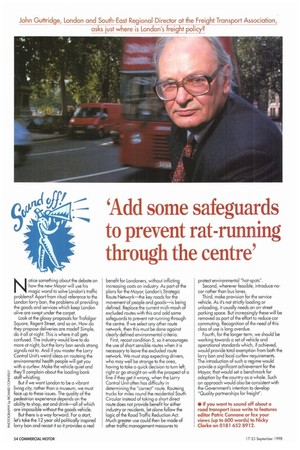'Add some safeguards to prevent rat-running through the centre'
Page 66

If you've noticed an error in this article please click here to report it so we can fix it.
Notice something about the debate on how the new Mayor will use his magic wand to solve London's traffic problems? Apart from ritual reference to the London lorry ban, the problems of providing the goods and services which keep London alive are swept under the carpet.
Look at the glossy proposals for Trafalgar Square, Regent Street, and so on. How do they propose deliveries are made? Simple, do it all at night. This is where it all gets confused. The industry would love to do more at night, but the lorry ban sends strong signals not to. And if you master the Lorry Control Unit's weird ideas on routeing the environmental health people will get you with a curfew. Make the vehicle quiet and they'll complain about the loading bank staff whistling. But if we want London to be a vibrant living city, rather than a museum, we must face up to these issues. The quality of the pedestrian experience depends on the ability to shop, eat and drink—all of which are impassible without the goods vehicle. But there is a way forward. For a start, let's take the 12 year old politically inspired lorry ban and recast it so it provides a real
benefit for Londoners, without inflicting increasing costs on industry. As part of the plans for the Mayor, London's Strategic Route Network—the key roads for the movement of people and goods—is being defined. Replace the current mish-mash of excluded routes with this and add some safeguards to prevent rat-running through the centre. If we select any other route network, then this must be done against clearly defined environmental criteria.
First, recast condition 5, so it encourages the use of short sensible routes when it is necessary to leave the excluded route network. We must stop expecting drivers, who may well be strange to the area, having to take a quick decision to turn left, right or go straight on with the prospect of a fine if they get it wrong, when the Lorry Control Unit often has difficulty in determining the "correct" route. Routeing trucks for miles round the residential South Circular instead of taking a short direct route does not provide benefit for either industry or residents, let alone follow the logic of the Road Traffic Reduction Act. Much greater use could then be made of other traffic management measures to protect environmental "hot-spots". Second, wherever feasible, introduce nocar rather than bus lanes.
Third, make provision for the service vehicle. As it's not strictly loading or unloading, it usually needs an on-street parking space. But increasingly these will be removed as part of the effort to reduce car commuting. Recognition of the need of this class of use is long overdue. Fourth, for the longer term, we should be working towards a set of vehicle and operational standards which, if achieved, would provide total exemption from both the lorry ban and local curfew requirements. The introduction of such a regime would provide a significant achievement for the Mayor, that would set a benchmark for adoption by the country as a whole. Such an approach would also be consistent with the Government's intention to develop "Quality partnerships for freight".
• If you want to sound off about a road transport issue write to features editor Patric Cunnane or fax your views (up to 600 words) to Nicky Clarke on 0181 652 8912.




























































































































